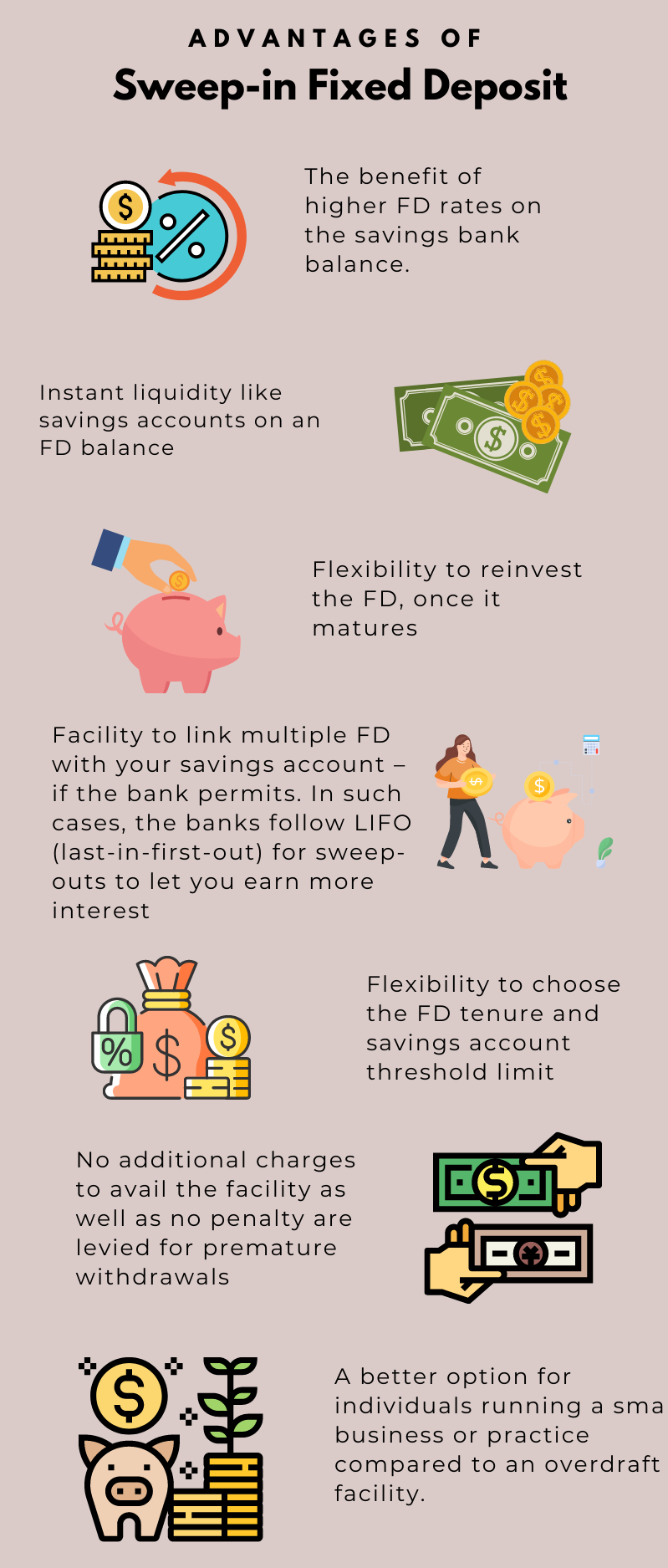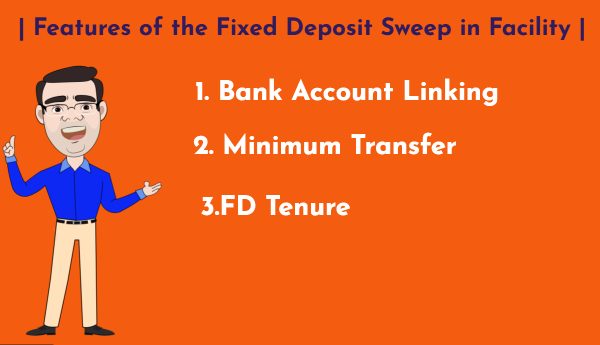In a Nutshell
- By linking one or more of your Fixed Deposits to your savings and current accounts you can enjoy better returns.
- Surplus funds above the threshold are transferred to the linked FD account under the Sweep-in facility.
- No need for manual intervention – the whole process is automatically triggered.
- Define your threshold depending on your liquidity needs.
- When funds beyond the threshold limit need to be withdrawn from the linked savings or current account, automatic sweep-out happens.

Must Check – Why Fixed Deposit & Debt Returns will always be Negative
There are no charges to avail of the sweep-in/out benefits.
The fixed deposit sweep-in facility allows the depositors to link their savings accounts with their fixed deposits accounts. Once the linking is complete and the threshold limit set, any balance above the limit is automatically transferred to the linked FD account and earns higher interest.
This automatic transfer is called the sweeping-in of the excessive balance, and hence the name Sweep-in FD facility.
Need for Fixed Deposit Sweep-in Facility
The current subdued interest rates on bank deposits are eating away at your returns. In these uncertain times, you also need a sizable balance in your savings accounts to meet any contingencies. As we always say, a balance to cover a minimum of six months’ living expenses is necessary.
But even with a modest monthly expense of Rs. 30,000/month, this sum turns out to be Rs. 1.5 lakhs. The prevailing savings account interest rates of around 2.5 to 3.0 percent give you negative returns. And the prevailing FD rates of 5.25 to 6.5 percent are barely above the inflation.
So, if you keep the funds in a savings account, you get the benefit of instant liquidity, but lose the interest income. While depositing funds in an FD gives you higher returns but robs you of the liquidity.
Investors often wonder, is there anything in-between that can offer you the best of both worlds – instant liquidity and higher returns?

Must Read – Fixed Deposit Vs Fixed Maturity Plan
It turns out there is – the Sweep-in Fixed Deposit schemes offered by most banks.
If you earn higher returns even on a portion of your cash/bank balance, it is not going to hurt you. That too without compromising any of the advantages of your savings account – instant liquidity for transfers, cheques, online/card transactions, and ATM withdrawals.
There are many instances when you suddenly get a liquidity infusion from one or more sources – the sale of assets, bonuses, and cash gifts. You may park any such one-time cash surplus about which you do not have immediate plans.
Features of the Fixed Deposit Sweep in Facility
1. Bank Account Linking
You must either link an existing current or savings bank account with a sweep-in FD account or open one at the home branch to avail of the sweep-in facility.
2. Minimum Transfer
Most banks transfer the surplus over the threshold limit in multiples of INR 1,000. Only a few banks allow such transfers below INR 1,000. You must check with your banker to get the exact details.
3. FD Tenure
The FD linked to the savings account has a minimum tenure of 1 year and can go up to 5 years.
Must check – 10 Questions if you are on the Path of Do It Yourself Investing
Fixed Deposit Sweep-out or Withdrawals
Just like your excess balance is transferred to the FD, if you need to withdraw funds more than your current balance in the linked savings account, a sweep-out occurs. The transferred surplus up to the limit of such transfers and accrued interest is available for withdrawal.
Remember, you cannot withdraw the original principal of the FD, or interest accrues on it, in a withdrawal. To utilize those funds, you will have to break the FD. If the linked savings account has a requirement of minimum balance in the savings account, then also a sweep-out may occur to meet it.
Interest rate
The sweep-in FD gets the same rate of interest as offered for a regular FD of similar tenure. However, as sweep-in comes with sweep-out, you will earn higher interest only for the duration of the balance being in the FD. Because of automation, the interest calculation is automatic and is credited to your savings account at each sweep-out.
Eligibility
Most banks require a depositor to open a sweep-in FD with a minimum value of INR 20 to 25 thousand. Once you have this FD in place, you can then link this FD to your savings bank account.

Must Read – Risk In Investment Everyone Should Know
Fixed Deposit Sweep-in: Explained by an Example
Let us say that you open a sweep-in FD at your bank with a tenure of 3 years and deposit INR 25,000 in it earning 5.75% annual interest. You can instruct your banker, online or offline, to link your savings account with this FD and define a threshold of, say, INR 30,000. It means any surplus in your savings account above that limit would be automatically swept into the linked FD.
When you receive a salary, bonus, or sale proceeds, in your savings account your balance may go up to, say, INR 1,05,250. The surplus, in multiples of INR 1,000, or INR 75,000 would be automatically transferred to the FD.
You can then continue to utilize your balance in the savings account as usual. If your balance drops to INR 11,000 and you need to make a payment for INR 25,000 then, a sum of INR 19,000 would be swept out from your FD.
19,000 + 11,000 = 30,000 = 25,000 + 5,000 (for minimum balance)
You will also get a credit for the accrued interest on the INR 19,000 for the period that it was in the FD. So, if your sweep-in happened on the 2nd of the month and the sweep-out on the 11th, then you will get INR 29.90 as interest in your savings account (the interest calculation by each bank may result in a slightly different value).
Advantages of Sweep-in Fixed Deposit
As is clear from the above illustration there are many advantages of opting for a sweep-in FD facility. Let us summarize them here:
- The benefit of higher FD rates on the savings bank balance.
- Instant liquidity like savings accounts on an FD balance.
- Facility to link multiple FD with your savings account – if the bank permits. In such cases, the banks follow LIFO (last-in-first-out) for sweep-outs to let you earn more interest.
- Flexibility to choose the FD tenure and savings account threshold limit.
- Flexibility to reinvest the FD, once it matures.
- No additional charges to avail the facility as well as no penalty are levied for premature withdrawals.
- A better option for individuals running a small business or practice compared to an overdraft facility.
Are Sweep-in FDs the same as Flexi-deposits?
NO.
The Flexi-deposit scheme is a separate scheme where the depositor has to manually deposit excess surplus from their savings account. It means whenever they need more cash than their current balance, the depositor must manually request for withdrawal of the said sum from the Flexi-deposit FD.
Both facilities offer similar benefits of higher interest rates and liquidity at no extra charges. The sweep-in facility is more convenient from the standpoint of convenience due to automatic transfers between your savings account and linked FD.
How to Start a Sweep-in Fixed deposit?
Check your bank’s website or visit your branch to see if your bank offers the sweep-in facility and what are its conditions. If the facility is available, then follow these steps:
- Open a new FD if you already do not have one.
- In the FD opening form, select the sweep-in option, if provided. This will affect the tenure of the FD.
- You can also link your savings or current account with the FD later.
- While linking, define the threshold for transferring surplus to the linked FD. It must not be less than the limit set by the bank.